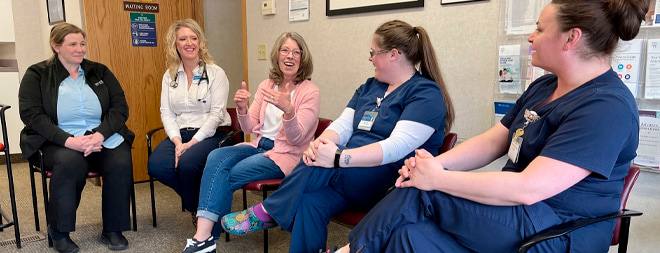
On a Monday in late March, Karren Smith was caring for her 6-year-old grandson when she started feeling a heaviness in her chest. At first, she brushed it off, thinking it was heartburn, but the feeling persisted so she took some aspirin.
Then she started feeling tingling in her left arm and soreness in her jaw. Given her family history of heart disease, she realized she needed to go to Mayo Clinic Health System in New Richland, Minnesota, just a few blocks from her home.
"I wasn't alarmed or scared, but was more worried for my grandson because he had to come with me," Karren says. "I had to stay calm for him."
Teamwork in action
When she arrived at the clinic, Karren told the staff what she suspected and they sprang into action.
"They were quick and knew exactly what to do," Karren says.
The staff took her vitals and performed an electrocardiogram, also known as an ECG or EKG, which revealed that she was experiencing a heart attack, or myocardial infarction.
Wendy Trihus, nurse practitioner, was the primary care provider in the clinic that day.
"Typically when someone walks in with chest pain, which happens a couple of times a year, it's heartburn, anxiety or muscle strain. It's not usually a heart attack in process," Wendy says.
Staff had a plan in place for this situation. However, because it's so rare to treat heart attack patients in the clinic, not all the needed emergency medications or equipment were available.
"That's why it was so important to move her quickly to a larger facility," Wendy says.
In Karren's case, the larger facility was Mayo Clinic Health System in Mankato, just 45 minutes away. The staff coordinated an ambulance to transport Karren to Mankato and transmitted to the team at the hospital all the information they had collected.
Cardiology care in Mankato
In Mankato, Ripu Singh, M.D., a cardiologist, and his team were waiting for Karren. From the ECG, Dr. Singh could see that Karren's heart attack was caused by a blockage in the coronary artery, which originates from the right side of the heart. Dr. Singh used specialized catheters inserted into an artery in Karren's right wrist to open the blocked artery and insert three stents.
Dr. Singh says Karren had several factors working in her favor for a good outcome. She didn't have many chronic conditions, and the rapid diagnosis and transfer by the New Richland team ensured that little time passed between the initial medical contact and putting in the stents.
"Time is of the essence. Delays at any stage can lead to heart damage," Dr. Singh says. "The sooner you can open a blocked artery, the less heart muscle dies. You really want to return blood flow within a 90-minute window."
Karren stayed in the hospital for 72 hours while the care team monitored her recovery and ensured her vitals and heart function were returning to normal.
"They were fantastic," Karren says, "I'd never seen Dr. Singh as a patient or even met him before this, but he did a great job."
Three months after her heart attack, Karren says she's feeling well and has returned to her normal activities, including taking care of her grandchildren. However, she does eat healthier and avoids excess salt. She also is on heart medications prescribed by her care team.
Learning from a not-so-normal experience
After caring for Karren, staff at New Richland held a debriefing to talk about their existing plan for caring for someone experiencing a heart attack, how their experience with Karren went and what they could do differently if the situation arises in the future. Overall, they were pleased with how they served the needs of their patient but did make some small tweaks, such as putting a clock in the room where they do ECGs so they can track giving medications and document events.

"We stuck with the plan, stayed calm, helped keep the patient calm and worked like a team, not only among ourselves, but also coordinated with all the teams along the way," Wendy says.
What women need to know about heart attacks
Heart disease is the No. 1 killer of women in the U.S., and according to the American Heart Association, 64% of women who die suddenly of heart disease had no previous symptoms. So it's crucial to for women to know about heart disease and heart attacks.
"Women get busy and don't take time for themselves, which often means they're not exercising as much as they should," Dr. Singh says. "For both women and men, if you're exercising, you may experience symptoms sooner, which can lead to treatment before you have a heart attack."
Other things women should know about their heart:
- Women tend to develop heart disease about 10 years later than men. At 66, Karren fell into the general age group when women begin to experience heart issues.
- Symptoms for women experiencing a heart attack can be more vague, including a sense of not feeling well, dizziness, nausea, extreme fatigue, shortness of breath and pressure in the upper back or pain in the neck.
- Because those symptoms often are similar to other conditions, it can be more difficult to diagnose a heart attack.
- Know your heart health numbers and understand that diabetes can significantly increase your risk of having a heart attack.
- Regular exercise and a healthy diet can significantly reduce your risk of a heart attack.
- If you have concerns about your heart health, consult with a cardiologist.
Sharing what she learned from her experience, Karren says, "Know your body. Listen to what it's telling you. Don't just assume it will go away. Get it checked out. And if it's nothing, great. But it might not be 'nothing.'"
This article originally appeared on the Mayo Clinic Health System blog.







